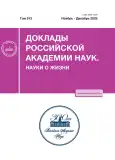AUTUMN MIGRATION OF THE GREATER NOCTULE BAT (NYCTALUS LASIOPTERUS): ACROSS COUNTRIES AND MOUNTAINS TO A NEW RECORD FOR THE RANGE OF SEASONAL FLIGHTS OF BATS
- Authors: Vasenkov D.A.1, Vasiliev N.S.2, Sidorchuk N.V.1, Rozhnov V.V.1
-
Affiliations:
- A.N. Severtsov Institute of Ecology and Evolution, Russian Academy of Sciences
- Lomonosov Moscow State University
- Issue: Vol 513, No 1 (2023)
- Pages: 564-569
- Section: Articles
- URL: https://journals.rcsi.science/2686-7389/article/view/244377
- DOI: https://doi.org/10.31857/S2686738923700403
- EDN: https://elibrary.ru/GTQDPL
- ID: 244377
Cite item
Full Text
Abstract
For the first time, using GPS-GSM trackers, long-term seasonal flights of greater noctule bat (Nyctalus lasiopterus) from summer habitats in Russia to wintering areas in Europe have been recorded. One of the seasonal migratory flights is a record distance for bats (2515 km). The maximum daily flight was 445 km. One of the animals abruptly changed the direction of migration from southwest to north on the third day of flight after crossing the Kursk magnetic anomaly.
About the authors
D. A. Vasenkov
A.N. Severtsov Institute of Ecology and Evolution, Russian Academy of Sciences
Author for correspondence.
Email: vasenkov.d@yandex.ru
Russian Federation, Moscow
N. S. Vasiliev
Lomonosov Moscow State University
Email: rozhnov-v-2015@yandex.ru
Russian Federation, Moscow
N. V. Sidorchuk
A.N. Severtsov Institute of Ecology and Evolution, Russian Academy of Sciences
Email: rozhnov-v-2015@yandex.ru
Russian Federation, Moscow
V. V. Rozhnov
A.N. Severtsov Institute of Ecology and Evolution, Russian Academy of Sciences
Author for correspondence.
Email: rozhnov-v-2015@yandex.ru
Russian Federation, Moscow
References
- Irving A.T., Ahn M., Goh G., et al. // Nature. 2021. V. 589. P. 363–370.
- Панютин К.К. // Итоги мечения млекопитающих. (Вопросы териологии). М.: Наука, 1980. С. 23–46.
- Hutterer R., Ivanova T., Meyer-Cords C., Rodrigues L. Bat migrations in Europe – A review of banding data and literature (Naturschutz und Biologische Vielfalt, V. 28). Bonn: Federal Agency for Nature Conservation Publ., 2005. 180 p.
- Ellison L.E. Summary and Analysis of the U.S. Government Bat Banding Program: U.S. Geological Survey Open-File Report 2008–1363, 2008. 117 p.
- Richter H.V., Cumming G.S. // Journal of Zoology. 2008. V. 275. № 2. P. 172–176.
- Welbergen J.A., Meade J., Field H. et al. // BMC Biol. 2020.18. 101.
- Dechmann D.K.N., Wikelski M., Varga K., Yohannes E., Fiedler W., et al. // PLoS ONE. 2014. V. 9 (12). P. e114810.
- Васеньков Д.А., Васильев Н.С., Сидорчук Н.В., Рожнов В.В. // Известия РАН. Серия биологическая. 2020. № 6. С. 665–672.
- Alcaldé J., Juste J. & Paunović M. 2016. Nyctalus lasiopterus. The IUCN Red List of Threatened Species 2016. P e.T14918A22015318.
- Петров О.В., Морозов А.Ф., Липилин А.В., и др. Центральный федеральный округ. Курская область. Карта Аномального магнитного поля. СПб.: ВСЕГЕИ, 2004 г.
- Đaković M., Pavlinić I. // Natura Croatica: Periodicum Musei Historiae Naturalis Croatici. 2022. V. 31. №. 2. P. 399–402.
- Popa-Lisseanu A.G., Bontadina F., Mora O., IbÁñez C. // Animal behaviour. 2008. V. 75. №. 2. C. 471–482.
- Lindecke O., Holland R., Pētersons G., Voigt C. // Communications Biology. 2021. V. 4. № 522.https://doi.org/10.1038/s42003-021-02053-w
- Кишкинёв Д.А., Чернецов Н.С. //Журнал общей биологии. 2014. Т. 75. №. 2. С. 104–123.
- Ротанова Н.М., Харитонов А.Л., Фрунзе А.Х., Филиппов С.В., Абрамова Д.Ю. // Геомагнетизм и аэрономия. 2005. Т. 45. № 5. С. 712–719.
- Weller T., Castle K., Liechti F., et al. // Sci. Rep. 2016. V. 6. P. 34585.
- Vasenkov D., Desmet J.F., Popov I., Sidorchuk N. // Mammalia. 2022. V. 86 (5). P. 524–526.
- Dietz C., Kiefer A. Bats of Britain and Europe. London: Bloomsbury Publ., 2016. 400 p.
- Racey P.A. // J. Reprod. Fert. 1974. V. 41. № 1. P. 169–182.
- Petit E., Mayer F. // Proceedings. Biological sciences / The Royal Society. 1999. V. 266. P. 1717–22.
Supplementary files











